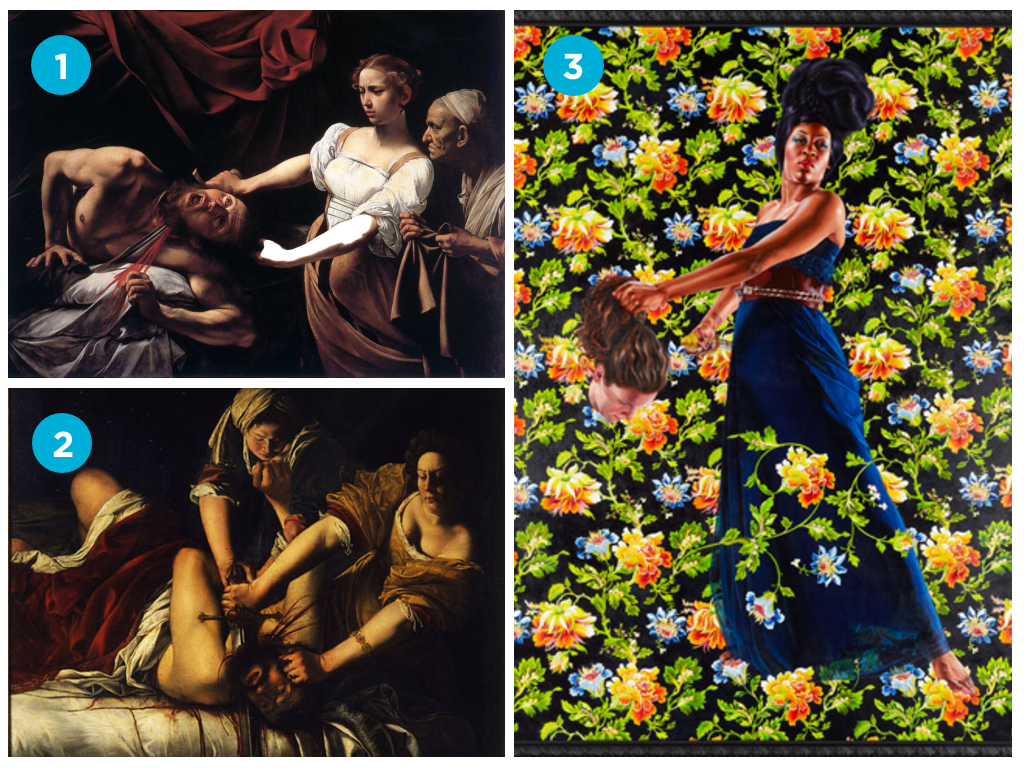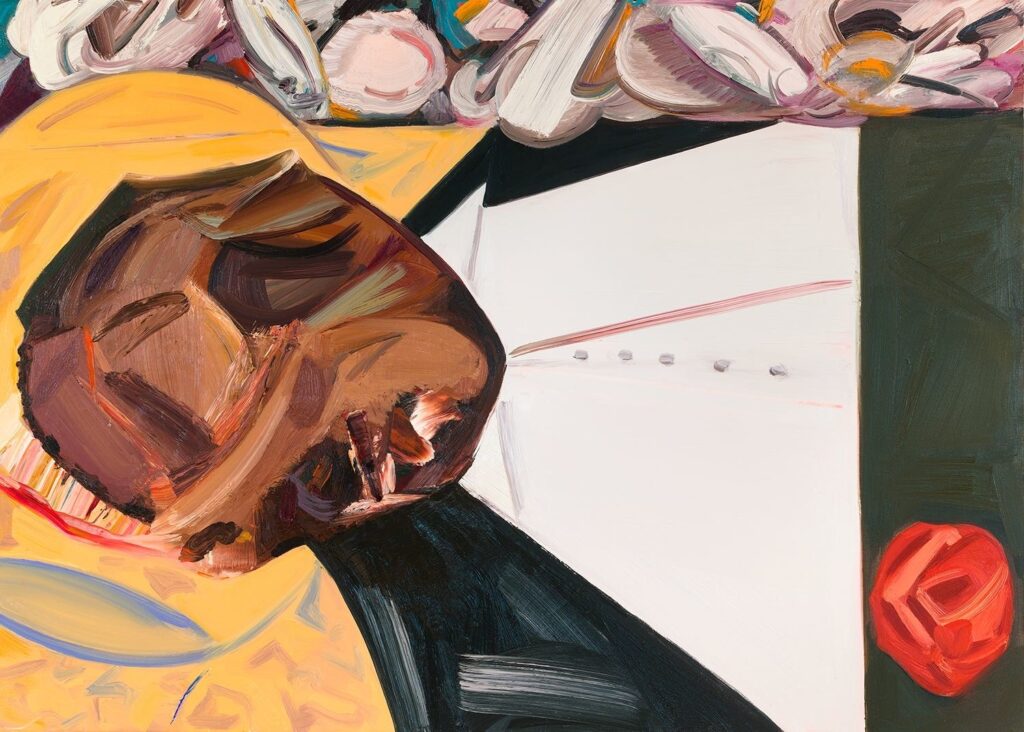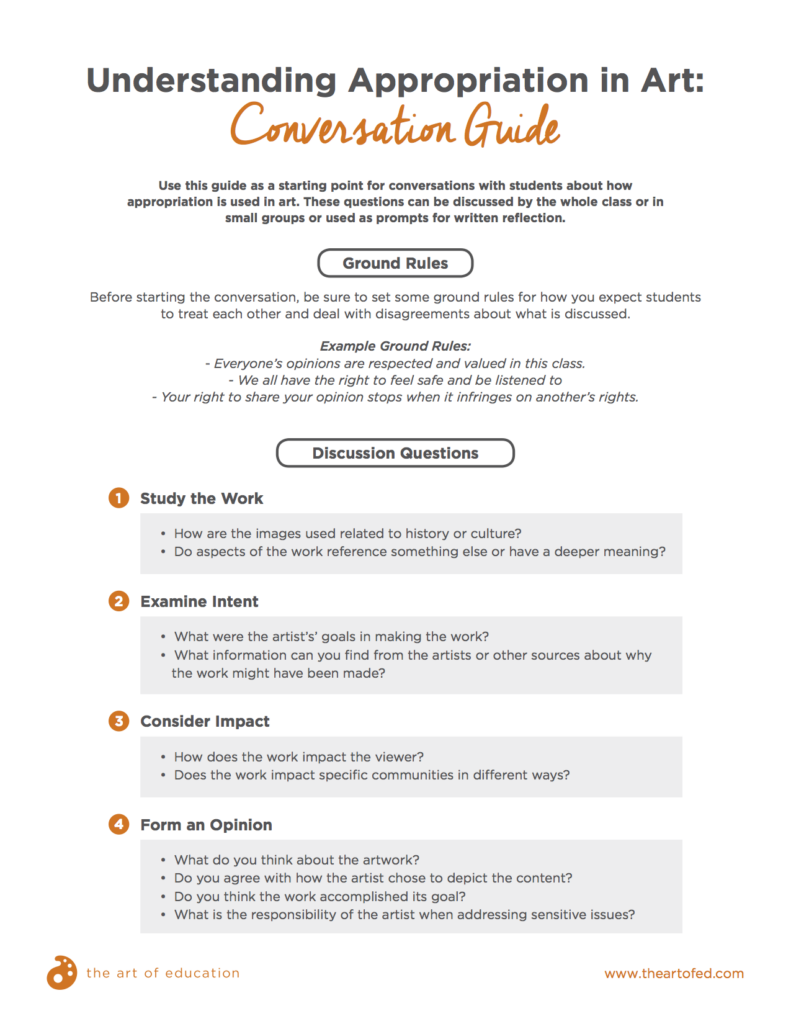Appropriation is a complex topic for art teachers to navigate. On one hand, the concept of borrowing ideas and images and incorporating them into new work is an essential part of how art is made. It’s considered so essential, in fact, it is directly protected by copyright law. This type of cultural exchange has a long history in visual art.
The Historical Example of Judith and Holofernes
For example, biblical stories like the tale of Judith and Holofernes have been repeated over and over in Western art. In 1599, Caravaggio took this conventional subject and upped the drama and gore. About 20 years later, Artemisia Gentileschi painted it from a feminist perspective. Then, in 2012, Kehinde Wiley created a version where he replaced the characters with modern versions. In this way, he built on the established context and created a piece layered with symbolism and meaning.

A Developing Societal Awareness
On the other hand, we have a developing societal awareness of cultural appropriation.
Cultural appropriation involves the exploitation of one group’s culture or history by another. In 2012, a clear example of appropriation happened at the highly-publicized Victoria’s Secret Fashion Show.
Model Karlie Kloss walked the runway in lingerie accessorized with turquoise jewelry and a full-length Native American war bonnet. Ruth Hopkins, a writer for Indian Country Today, explains why this is problematic.
She writes, “For one, Ms. Kloss has no business wearing a war bonnet at all. Not only is she not Native, she hasn’t earned the honor. Among my people, the Oceti Sakowin (Sioux), war bonnets are exclusively worn by men, and each feather within a war bonnet is symbolic of a brave act of valor accomplished by that man. Not just any Tom, Dick or Harry had the privilege of wearing a war bonnet. Who wears a war bonnet? Tatanka Iyotanka, Sitting Bull.”
Is There a Middle Ground?
If we look at borrowing in art as a continuum, with artistic appropriation on one end and cultural appropriation on the other, it’s pretty clear what we want to avoid.
Most of us can agree that acts which sexualize, disrespect or demean other’s cultures are morally wrong.
The tricky part is the gray area in the middle. Where is the line between the valuable appropriation artists engage in and cultural appropriation?
The Recent Example of Dana Schutz’s Open Casket
A recent work shown at the Whitney Biennial has caused the art world to wrestle with these questions, with no clear answers. Artist Dana Schutz, who is white, painted Emmett Till in his open casket. Till was a black teenager who was lynched by a mob at age 14 in Mississippi in 1955 for talking to a white woman. His mother gave witness to this atrocity, and galvanized the civil rights movement, by releasing a photo of Emmett’s mangled face in his open casket. That photo served as inspiration for Schutz’s work.

There’s no doubt this piece is controversial and polarizing. But is it an act of adding meaning to a visual image to further artistic goals or an example of exploitation? Opinions within the art community vary widely.
Many artists expressed outrage at Schutz’s work. They felt it was unprincipled and an inappropriate subject for white artist to tackle.
In an open letter to the curators of the exhibit signed by nearly 50 Black artists Hanna Black wrote, “In brief: the painting should not be acceptable to anyone who cares or pretends to care about Black people because it is not acceptable for a white person to transmute Black suffering into profit and fun, though the practice has been normalized for a long time.”
In addition, artist Parker Bright protested the work by standing in front of it as it hung in the gallery. He said, via Facebook Live during the protest, “To me, it just seems like a scheme for the Whitney to create controversy.”
In response, Christopher Yew, co-curator of the show explained his intentions saying, “I think it’s positive in the sense that people are coming to see the painting in the show, to debate the artworks that are in the show, and have these conversations around topics that are difficult to talk about.” According to both the artist and the Whitney, the painting has never been for sale.
What do these complex issues mean for teachers in the classroom?
Appropriation is a constant part of our students’ lives as they are exposed to visual culture every day through multiple forms of print and online media. We can help our students process the increasingly visual world we live in by discussing how artists use the work of others. In turn, we can help them develop their own opinions about what they see.
One way to frame this discussion is to encourage students to look at the intent, impact, and responsibility of artists by asking questions like:
- What did the artist intend when creating the art in question?
- How does the work impact the viewer?
- Does the work impact specific communities in different ways?
- What is the responsibility of the artist when addressing sensitive issues?
If you’d like, you can download the discussion guide below to use with your students.
This guide features helpful tips for setting ground rules and a set of guiding questions. The second page features only the questions so you can distribute them to your students for small group discussions. We’ve even left enough room to cut the questions apart if you so choose!
Teaching students about appropriation can have valuable classroom implications.
Showing students how artists borrow, change, subvert, and combine images to create new meaning is essential if we want them to understand the art world and develop meaningful ideas. In my classroom, I use an art remix activity to get students to think deeply about this topic.
In addition, it’s valuable to help students examine current debates about cultural appropriation. Not only is it an engaging way to dissect pop culture through visual analysis, it’s great practice for students to form their own opinions and draw their own conclusions.
Ultimately, the truth about appropriation is complicated. By teaching students about this complex subject, we can help students navigate modern culture and more deeply understand the past and present of the visual art world.
Do you discuss appropriation in your classroom?
Do you have any suggestions about how to foster a respectful and meaningful dialogue?
Magazine articles and podcasts are opinions of professional education contributors and do not necessarily represent the position of the Art of Education University (AOEU) or its academic offerings. Contributors use terms in the way they are most often talked about in the scope of their educational experiences.





